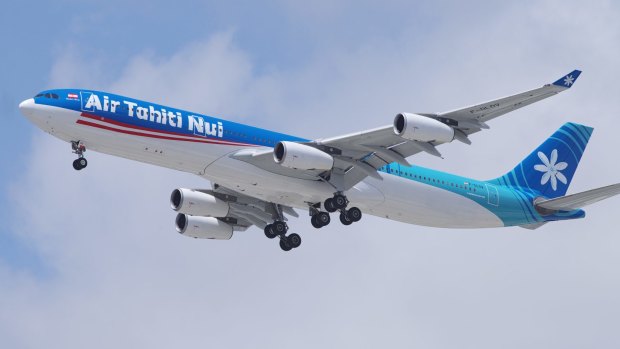This was published 2 years ago
What is the difference between direct and non-stop flights? The longest non-stop and direct flights

During the pandemic Air Tahiti Nui set a record for the world's longest non-stop commercial flight, though it was a one-off.Credit: iStock
Is the current Qantas flight from Darwin to London a "direct" or a "non-stop" flight? If you said "direct", go straight to the back of the economy class cabin please. It's a non-stop flight, but the QF1 flight from Sydney to London via Darwin? That's a direct flight.
Although the terms "direct" and "non-stop" are used casually, and interchangeably, to the chagrin of air travel pedants such as myself, they're not the same.
A non-stop flight is exactly what the name says, A to B with no stops in between. A direct flight means a stop somewhere between A and B, aboard an aircraft that uses the same flight number for the entire journey. Also, it must be aboard a single airline rather than a partial codeshare flight, such as Air New Zealand's flight from Auckland to London via Los Angeles, which uses the same flight number although passengers transfer to British Airways or a US carrier for the LAX-London sector.
It's common knowledge that the Singapore Airlines flight from Singapore to New York at 15,353 kilometres holds the current record as the longest non-stop scheduled flight. Some claim that number one spot for Air India flight 173, which flies from New Delhi to San Francisco four times per week, and regularly records an actual distance flown of 15,500-plus kilometres aboard a Boeing 777-200LR, although the distance between the two cities is considerably shorter, just 12,295 kilometres.
The same applies to the Singapore Airlines' Singapore-New York flight, the actual distance flown is typically in excess of 16,600 kilometres, or more than 1200 kilometres greater than the straight-line distance. The actual distance flown is always going to be greater than the great circle route, the path of shortest distance between two points on the surface of a sphere, since pilots deviate from that route as circumstances require.
Some of those records were challenged during the pandemic. On March 15, 2020, an Air Tahiti Boeing 787-9 flew from Tahiti's Faa'a International Airport to Paris non-stop, a distance of 15,715 kilometres. That made it the world's longest ever non-stop commercial flight, although it was to be a one-off, with ongoing flights between Tahiti and Paris routed through Canada's Vancouver and Guadeloupe. The Boeing 787-9 has a range of 13,950 kilometres, but by flying in an easterly direction, and thereby taking advantage of the jetstream, the aircraft was able to outrun that limitation.
Finding the world's longest direct flight is not so easy. Since they break their journey at some point, direct flights don't have the same kudos that attaches to the world's longest non-stop flights, and thus they don't enter the record books. The current QF1 flight, travelling from Sydney to London via Darwin, is one of the longest, at a total distance of 17,123 kilometres, according to Flight Radar 24. Air France flight AF076, the regular service between Paris and Papeete with a stop in Los Angeles, is another big leaguer at over 15,000 kilometres. Singapore Airlines flight SQ52, Singapore to Houston via the UK's Manchester, is longer still, 18,546 kilometres.
History provides some fascinating examples of direct flights, some of which dwarf the present-day offerings. Korean Air flight KE062, which operated between Seoul and Brazil's Sao Paolo from 1992 to 2016, covered a whopping 19,480 kilometres. That's just slightly longer than Qantas' original "kangaroo route" to London, which began on December 1, 1947. From Sydney, the route took the Lockheed Constellation to Darwin, Singapore, Calcutta, Karachi, Cairo and Tripoli before finally reaching London. Adding all those stops together using Air Miles Calculator gives a total distance travelled of 19,251 kilometres.
In 1964 Qantas began a third variation of the kangaroo route, via the Pacific this time, aboard a Boeing 707, departing Sydney and stopping in Nadi, Papeete, Acapulco, Mexico City, Nassau, Bermuda and finally London. Adding all those stops together using Air Miles Calculator gives a total of 22,948 kilometres. Known as the Fiesta Route, it lasted only 11 years, killed off by increasing fuel costs and the introduction of the Boeing 747.
Sign up for the Traveller newsletter
The latest travel news, tips and inspiration delivered to your inbox. Sign up now.